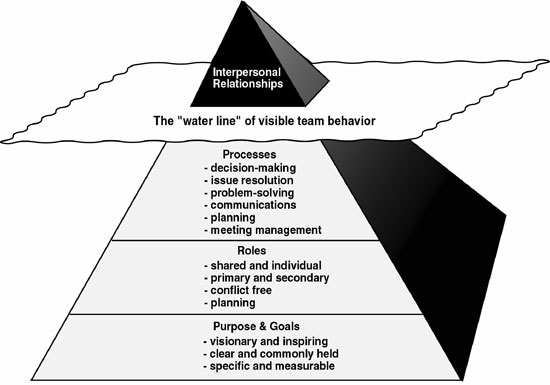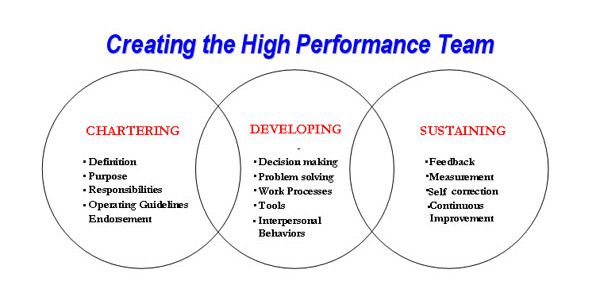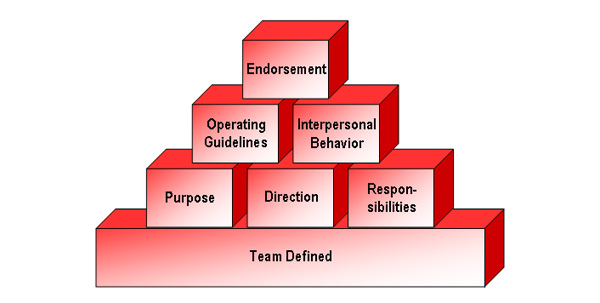About the Process
Organizations rely on teams for much of their complex work. Sometimes teams are designed to achieve high priority internal goals, such as designing and implementing a new enterprise software system, or managing an acquisition or merger. Sometimes teams are designed to implement client projects. When the project is large in scope, the team is cross-functional, the interdependencies are high and the results are time and budget sensitive, the best approach is to engage in a formal team alignment process.
Team alignment is much more than traditional team building. Team building sessions often focus on the interpersonal aspects of team development. The team alignment process may include interpersonal development activities, but its primary focus is to ensure a team that is prepared to execute its work properly, achieving the potential synergies of an aligned and empowered group of talented individuals.
Critical Success Factors for an Effective Aligned Team
In order for a team to function effectively, several specific criteria must be in place. If any of these elements are missing, the team may become a group of individuals who spend their time debating with each other and have a negative impact on each other’s work, rather than an integrated team. In order for a team to achieve synergistic results, the following criteria must be in place.
-
The team must have a common agreed upon aligned charter.
The team charter is represented through a set of common goals, measures and rules known, understood and agreed to by all team members.
-
The team members must be committed to the goals and tasks required.
If a task has been allocated 50 hours, the individual assigned must agree that it can be done in that time frame, and be personally committed to achieving that result. Lack of commitment to the goals will lead to failure.
-
The team members must be committed to each other.
The team members accept each other and are committed to working together and to ensuring each other’s success.
-
The team members must be interdependent.
The team members must need each other to be successful. Each person’s work must be linked to the work of the other team members and the overall team goals if teamwork is to be achieved.
-
The team members must have both collective and individual accountability.
The team result must be clearly related to each person’s success. If the team fails to achieve its goals, then each team member must share responsibility for the overall lack of results regardless of who did or did not do the work. Each individual team member’s goals must be clearly identified and accepted, and that person must be responsible for those results. The entire team must endorse the accountability for every team member.
-
The team members must demonstrate acceptable team behavior.
There are a number of key personal and interpersonal behaviors that are essential for a team to perform well when it is together. Every member of the team must demonstrate these behaviors.
-
Resources must be adequate to perform the work as a team.
These resources must be identified in the team’s work plan and supported through project endorsement.
The Team Alignment Pyramid
The first stage of team alignment is very often the most important. The investment in aligning a team is essential in creating the foundation for excellent performance. Most team problems can be traced back to unresolved initial issues such as unclear goals, lack of commitment, role confusion, inadequate communication, misunderstanding about the decision-making process, and other factors that can be discussed and resolved in the initial chartering process.
The following graphic - The Team Pyramid - illustrates how the elements of team alignment (seen below the water line) are directly related to and affect interpersonal behavior (seen above the water line).

How the Team Alignment Process Works
There are many approaches that can be taken depending on the nature of the goals of the team. However, teams always go through three major steps: chartering, developing, and then sustaining high performance.

The process of team alignment focuses on the Chartering phase. This is based on the premise that "an ounce of prevention is worth a pound of cure." Chartering is the process by which a team defines itself, its goals, its responsibilities, and its operating guidelines. The chartering model is shown below:

The scope of the chartering process depends on the size and nature of the team and the complexity of the work. It may vary from a day to multiple sessions over a period of time.
If team building for external projects is also to include the client, then it is customary to have an alignment session first with the internal team; then a separate session with the client team; and then bring the teams together to build their combined charter.
Team Chartering and Alignment Steps
Although the content of every alignment process will be determined by the requirements and circumstances of that team’s goals, the following outline contains a suggested list of items that must be either developed or reviewed and confirmed by the team.
Step One- Defining the team project or goals
The team should begin by reviewing its goals or requirements. The specific specifications or deliverables must be examined and discussed. Any contractual documents or client agreements also need to be shared.
At the end of this step the entire team should have a common understanding and commitment to the team’s vision and its specific goals. There should be no misunderstanding about the definition of success.
Step Two – Reviewing/confirming the team implementation strategy
There is rarely only one way to do anything. We all have preferences and ways of accomplishing our work and these approaches are frequently different.
A strategy defines the higher level HOW work will be done; not the WHAT. Once strategies are set and agreed, they drive the lower level tactical implementation.
Successful teams typically have very specific execution strategies that govern their decisions. The strategic issues, challenges and opportunities facing the team should be surfaced at this point of the alignment process, addressed by the team, and a set of agreed upon execution strategies developed. By surfacing, asking and agreeing to the core strategies, the team will begin building a common vision of how its work will best be implemented.
Step Three– Reviewing and confirming the integrated team work plan
Implementation plans can be developed at many different levels of detail.
At the highest level, there is no real plan at all - simply a delivery date. At the lowest level, professional planners develop incredibly detailed plans showing resource allocations to the hour for thousands of people. The level of planning needed by a team falls somewhere between these two extremes.
A plan that only sets a delivery date is of little use. The requirements may be known but there is no guidance regarding what is the most important thing to do at any moment in time and no knowledge of whether the work of the team is on schedule.
Conversely, planning at the most detailed level may be important to guide work and resources on a daily basis, but it is of little value in managing the team’s work at the level required of the team leader and core team members.
The plan that should be developed by the team in the alignment process is one in which the key tasks and the integration of different components are clearly indicated. The purpose is to develop and confirm the sequence and interdependence of these tasks, as well as the schedules. This will enable the team to determine whether the resources and schedule can meet the team’s commitments. It will also ensure that the tasks and schedule are conforming to the execution strategies developed in the previous step.
Step Four – Developing the team organization and governance model
Step Five – Measures and controls
The next step is to identify the key measures to assess performance and progress against the team’s work deliverables. From these measures, decisions can be made about the control system needed to generate this information, the data inputting requirements and the reports – in format and level of detail – that will be most useful.
Assignment of responsibilities for providing the data, analyzing it, integrating it, creating the reports and reviewing and acting on the outputs should also be made at this time.
Step Six - Defining roles and responsibilities
Roles and responsibilities are the next step, and contain several elements. The first question is: What are the team’s collective responsibilities? This is a question that often goes unasked – all the responsibilities are set at the individual level. But there are some responsibilities requiring the collective work of the team. For example, the integrated work plan and schedule belongs to the team, not to any one individual. The budget for the team’s work and the allocation of key resources may also be collective work products.
Once the collective team responsibilities have been defined, primary responsibilities for each core team member should be developed, negotiated, and agreed by the entire team. To the extent possible, measures should be established for each core responsibility.
Step Seven – Establishing operating guidelines
The operating guidelines for the work of a team can also be termed the "rules of engagement." They define how the team will work together. Some typical areas for which guidelines may be needed are:
-
Meetings – who, how often, for what purpose
-
Communications – what and how
-
Reports – what is needed by whom and in what format
-
Changes – how do we respond to internal and external changes
-
Conflict – how is it resolved and how is it escalated when it cannot be resolved
-
Risk management – what levels of risk should be surfaced at the team level and how should it be addressed
-
Decision-making – what type of decisions are made at what levels
-
Interpersonal behaviors – what are the guidelines for how team members will treat each other, the project and the client.
The operating guidelines should be discussed, agreed, written down and shared. They become the standards for how the team will work together and helps the team move rapidly to accepted norms of behavior. As the work progresses these guidelines may need to be modified or additional guidelines created. This should be a living document that is always subject to further consideration.
Step Eight – Developing the customer or client relationship model
The customer or client may be internal or external. The fundamental relationship may range from a full partnership and integrated team at one extreme to an arms length relationship at the other. The client may want to be fully engaged and informed or may prefer to know as little as possible.
Regardless of the circumstances, the team should discuss the nature of this relationship and develop its plan for working with the client. This plan should be developed with and agreed by the client to ensure both the success of the work and the success of the relationship.
Step Nine – Alignment endorsement and action planning
Once the alignment is complete it should be reviewed and endorsed by the team, the client, and the company’s management. After endorsement, the team charter should be shared with all those connected to the work of the team.
The clearer the team charter, the easier it is for others to interact with the team and for the team to integrate new members quickly and efficiently.
Once complete, the aligned and endorsed charter is the team’s primary tool for leading its work.
Establishing a Team Alignment Process
Interested organizations should begin this process by phoning or sending an email to wsa@worksystemscanada.com describing the nature of their organization, their team, its work, and its work scope. This request will then be reviewed and further discussions can be scheduled to determine whether an engagement would be appropriate.
